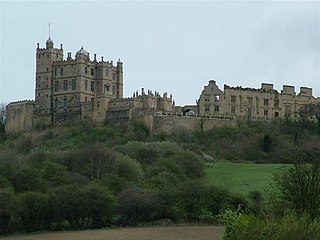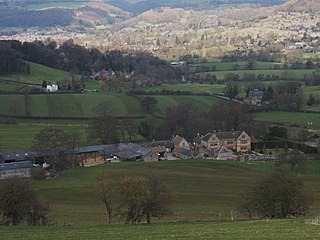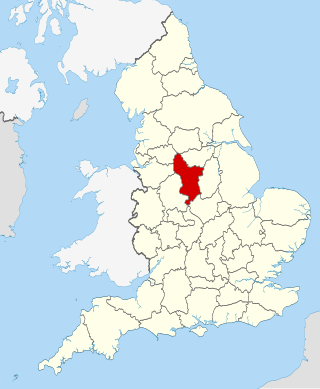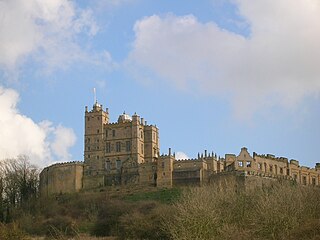Related Research Articles

Bolsover Castle is in the town of Bolsover, in the north-east of the English county of Derbyshire. Built in the early 17th century, the present castle lies on the earthworks and ruins of the 12th-century medieval castle; the first structure of the present castle was built between 1612 and 1617 by Sir Charles Cavendish. The site is now in the care of the English Heritage charity, as both a Grade I listed building and a Scheduled Ancient Monument.

Lyme Park is a large estate south of Disley, Cheshire, England, managed by the National Trust and consisting of a mansion house surrounded by formal gardens and a deer park in the Peak District National Park. The house is the largest in Cheshire, and is recorded in the National Heritage List for England as a designated Grade I listed building.

The history of Derbyshire can be traced back to human settlement since the last Ice Age, over 10,000 years ago. The county of Derbyshire in England dates back to the 11th century.

Hardwick Hall in Derbyshire is an architecturally significant country house from the Elizabethan era, a leading example of the Elizabethan prodigy house. Built between 1590 and 1597 for Bess of Hardwick, it was designed by the architect Robert Smythson, an exponent of the Renaissance style. Hardwick Hall is one of the earliest examples of the English interpretation of this style, which came into fashion having slowly spread from Florence. Its arrival in Britain coincided with the period when it was no longer necessary or legal to fortify a domestic dwelling.

Percy Bond Houfton (1873–1926) was a late-19th century and early-20th century English architect.

Barlow is a village and civil parish in the North East Derbyshire district of Derbyshire, England. According to the 2001 census the parish had a population of 884, increasing to 920 at the 2011 Census. The village is about 4 miles north-west of Chesterfield.

Sutton Scarsdale Hall is a Grade I listed Georgian ruined stately home in Sutton Scarsdale, just outside Chesterfield, Derbyshire.

Barlborough Hall is a Grade I listed 16th-century country house in Barlborough, Chesterfield, Derbyshire. It was built in around 1583-84 for Sir Francis Rodes and is attributed to Robert Smythson.

The River Hipper is a tributary of the River Rother in Derbyshire, England. Its source is a large expanse of wetlands, fed by the surrounding moors between Chatsworth and Chesterfield, known as the Hipper Sick on Beeley Moor, which is part of the Chatsworth Estate. It then passes through Holymoorside and down into Chesterfield, just south of the town centre, before flowing into the River Rother. In July 2007, parts of Chesterfield flooded when the River Hipper burst its banks during a substantial storm that caused extensive flooding in North Derbyshire and South Yorkshire. The river burst its banks again after torrential rain in October 2023. The surrounding landscape is known as the Hipper Valley.

Godfrey Bagnall Clarke, of Sutton Scarsdale Hall in Derbyshire, was a British Member of Parliament, representing Derbyshire.
Godfrey Clarke, was an English landowner and politician who sat in the House of Commons from 1710 to 1734.

Snitterton Hall is a late medieval manor house in Snitterton in South Darley parish, near Matlock, Derbyshire, England, and within the Peak District National Park. It is a Grade I listed building.

Barlow Woodseats Hall is a Grade II* listed manor house situated at Barlow Woodseats, on the edge of the village of Barlow, in Derbyshire. It remains the only manor house in the Parish of Barlow, and the current house dates from the early 17th century, although there are much earlier origins to before 1269.

Carnfield Hall is a privately owned country house located at South Normanton, near Alfreton in Derbyshire, England. It is a Grade II* listed building. The estate includes around ninety acres of park and ancient woodland.

Camerton Court is a historic house in the village of Camerton, Somerset, England. It has been designated as a Grade II listed building.

The county of Derbyshire is divided into nine districts. The districts of Derbyshire are High Peak, Derbyshire Dales, South Derbyshire, Erewash, Amber Valley, North East Derbyshire, Chesterfield, Bolsover, and Derby.

This is a list of scheduled monuments in the district of Bolsover in the English county of Derbyshire.
Barlow is a civil parish in the North East Derbyshire district of Derbyshire, England. The parish contains 18 listed buildings that are recorded in the National Heritage List for England. Of these, three are listed at Grade II*, the middle of the three grades, and the others are at Grade II, the lowest grade. The parish contains the village of Barlow and the surrounding countryside, mainly to the west of the village. It is almost entirely rural, and the listed buildings are mainly houses and associated structures, farmhouses and farm buildings. The other listed buildings are a church, its former rectory, a bridge, a former school, a pinfold, and a village pump.
Chesterfield is a town and an unparished area in the Borough of Chesterfield, Derbyshire, England. The town and surrounding area contain 208 listed buildings that are recorded in the National Heritage List for England. Of these, one is listed at Grade I, the highest of the three grades, 14 are at Grade II*, the middle grade, and the others are at Grade II, the lowest grade. Most of the listed buildings are houses, cottages and associated structures, shops, banks and offices, public buildings, farmhouses and farm buildings. The other listed buildings include churches, chapels and items in churchyards, public houses, former mills, a lock on the Chesterfield Canal and a bridge crossing it, lamp posts and lamp standards, a town pump, a former workhouse, former schools, a market hall, cemetery buildings, a memorial hall later used as a museum, statues, four war memorials, a cinema and ballroom, and a bandstand and a conservatory in Queen's Park.
References
- ↑ Historic England. "Somersall Hall (Grade II) (1088244)". National Heritage List for England . Retrieved 18 September 2015.
- ↑ Gardens (en), Parks and (31 December 1599). "Somersall Hall - Chesterfield". Parks & Gardens. Retrieved 23 September 2024.
- ↑ Historic England. "Gazebo at Somersall Hall (Grade II*) (1203393)". National Heritage List for England. Retrieved 18 September 2015.
- ↑ Historic England. "Pair of gatepiers near front door of Somersall Hall (Grade II) (1334695)". National Heritage List for England. Retrieved 18 September 2015.
- ↑ Houses in Derbyshire: Chatsworth House, Calke Abbey, Bretby Hall, Kedleston Hall, Bolsover Castle, Sudbury Hall, List of Monastic Houses in Derbyshire. General Books. ISBN 978-1-230-63344-2.
- ↑ Hall, Rev George (1839). The History of Chesterfield: With Particulars of the Hamlets Contiguous to the Town, and Descriptive Accounts of Chatsworth, Hardwick, and Bolsover Castle [with Additions]. Whittaker & Company.
- A History of the County of Derby Glover and Noble (1829) p.143, Google Books
53°13′33″N1°28′22″W / 53.2257°N 1.4728°W